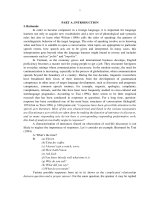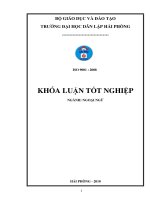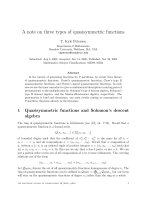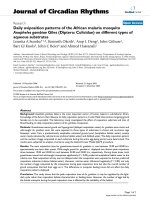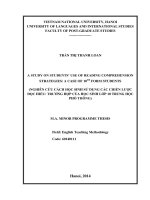A study on different types of verbal responses to questions in english conversations with reference to the vietnamese equivalents
Bạn đang xem bản rút gọn của tài liệu. Xem và tải ngay bản đầy đủ của tài liệu tại đây (996.22 KB, 68 trang )
MINISTRY OF EDUCATION AND TRAINING
HANOI OPEN UNVERSITY
LƯU THỊ THÚY HẰNG
A STUDY ON DIFFERENT TYPES OF VERBAL
RESPONSES TO QUESTIONS IN ENGLISH
CONVERSATIONS WITH REFERENCE TO THE
VIETNAMESE EQUIVALENTS
(NGHIÊN CỨU VỀ NHỮNG CÁC LOẠI LỜI ĐÁP
KHÁC NHAU CHO CÂU HỎI ĐÀM THOẠI TIẾNG
ANH TRONG SỰ LIÊN HỆ TƯƠNG ĐƯƠNG VỚI
TIẾNG VIỆT )
M.A. THESIS
Field: English Language
Code: 60220201
Hanoi, 2015
MINISTRY OF EDUCATION AND TRAINING
HANOI OPEN UNVERSITY
LƯU THỊ THÚY HẰNG
A STUDY ON DIFFERENT TYPES OF VERBAL
RESPONSES TO QUESTIONS IN ENGLISH
CONVERSATIONS WITH REFERENCE TO
THE VIETNAMESE EQUIVALENTS
(NGHIÊN CỨU VỀ NHỮNG CÁC LOẠI LỜI ĐÁP KHÁC
NHAU CHO CÂU HỎI ĐÀM THOẠI TIẾNG ANH TRONG SỰ
LIÊN HỆ TƯƠNG ĐƯƠNG VỚI TIẾNG VIỆT )
M.A. THESIS
Field: English Language
Code: 60220201
Supervisor: Assoc. Prof. Dr. Võ Đại Quang
Hanoi, 2015
CERTIFICATE OF ORIGINALITY
I, the undersigned, hereby certify my authority of the study project
report entitled A STUDY ON DIFFERENT TYPES OF VERBAL
RESPONSES TO QUESTIONS IN ENGLISH CONVERSATIONS WITH
REFERENCE TO THE VIETNAMESE EQUIVALENTS submitted in
partial fulfillment of the requirements for the degree of Master in English
Language. Except where the reference is indicated, no other person’s work
has been used without due acknowledgement in the text of the thesis.
Hanoi, 2015
Luu Thi Thuy Hang
Approved by
SUPERVISOR
(Signature and full name)
Dr. Vo Dai Quang
Date:……………………
i
ACKNOWLEDGEMENT
First and foremost, I would like to express my deepest gratitude to
my professor, Dr. Vo Dai Quang . From the point of a teacher, an advisor
and a mentor, you introduced and inspired me to do this research. My
professional development has been growing increasingly with your
precious guidance and continuous motivation.
My special thanks go to all my lectures in Post-graduate
Department of Ha Noi Open University for their precious assistance,
knowledge and enthusiasm.
I own my parents for their constant source of love, support and
encouragement. I am immensely grateful to them for standing behind me
whenever I needed them especially in times of difficulties.
I would also want to extend a special shout-out to all the research
participants. Without your valuable opinions and ideas on the
questionnaire, the project would not have been accomplished.
Finally, my special thanks go to all my dear friends for their
understanding and assistance during the process of preparing this
research. I count each of you as my special blessings.
While I am greatly indebted to all of these people for their tireless
help to my completion of this thesis, I myself remain responsible for any
inadequacies that are found in this work.
Luu Thi Thuy Hang
ii
ABSTRACT
Communication is the essential need of human. It has incessantly
improved and developed during our whole life. Communication helps us
to acquire and increase knowledge from the outside world and strengthen
relations between people, especially those from different cultures and
countries. In workplace, many organizations are losing valuable business
opportunities because they have failed to recognize the fundamental
importance of effective communication. It is communication breakdown
that is at the root of conflicts or misunderstanding among colleagues.
Staff’ success also depends not only on professionalism and diligence
but their individual relationships and communication skills as well.
In Vietnam nowadays, the country is integrating into the global
village. More and more foreign companies and organizations have been
sprung up like mushroom. Therefore, communication skills with foreign
counterparts play an important role in enhancing the efficiency and
effectiveness of their work. Vietnamese staff’s ability to communicate
with foreigners has become a subject of discussion.
Due to the differences in response type usage to questions across
cultures, it is unavoidable for Vietnamese learners of English to have
some problems in responding to questions. On the basis of analyzing
these problems, some suggestions for better teaching and learning of
English in Vietnamese are presented. I hope this paper will help students
understand the differences of verbal resonses to questions in Vietnamese
and English conversation to become more proficient in their studying of
English.The study hopes to provide a comprehensive picture of response
patterns to question both in English and Vietnamese conversation.
iii
LIST OF TABLES AND ABBREVIATIONS
1. Lists of abbreviations
Q: Question
A: Answer
E: English
V: Vietnamese
DCT: Discourse Completion Test
NSE: Native Speaker English
NSV: Native Speaker Vietnamese
2. Lists of tables
Table 1: Correlation of content and format in adjacency pair ................................11
Table 2: Forms of indirect responses to questions .................................................22
iv
TABLE OF CONTENTS
Certificate oforiginality…………………………………………...............
i
Acknowledgement………………………………………………...……....
ii
Abstract……………………………………………………………………
iii
List of tables and abbreviations ..................................................................
iv
Table of contents ......................................................................................
v
CHAPTER 1 : INTRODUCTION
1.1. Rationale ........................................................................................…
1
1.2. Aims of the study ...........................................................................…
2
1.3. Objectives of the study ...................................................................…
2
1.4. Scope of the study ..........................................................................…
3
1.5. Significance of the study ................................................................…
3
1.6. Structure of the study .....................................................................…
3
CHAPTER 2 : LITERATURE REVIEW
2.1 Review the previous study ..................................................................
5
2.1.1.Review of previous studies overseas…………………………..........
5
2.1.2.Review of previous studies in Vietnam..............................................
5
2.2 Review the theoretical background .....................................................
7
2.2.1 Conversational theory ..................................................................…
7
2.2.1.1.Conversation.....................………………………………………...
7
2.2.1.2 .Conversation structure....................................................................
8
2.2.1.3. Conversation analysis.....................................................................
9
2.2.1.4.Conversational principle..................................................................
14
2.2.1.5. Verbal communication....................................................................
17
2.2.2. Questions and Responses...................................................................
18
2.3.Summary................................................................................................
26
CHAPTER 3: METHODOLOGY
3.1.Research-governing orientations .....................................................…
27
v
3.1.1. Research questions ......................................................................…
27
3.1.2. Research setting.................................................................................
27
3.2. Research methods.................................................................................
28
3.2.1.Data collection ...................................................................................
28
3.2.2.Data analysis.......................................................................................
30
3.3.Summary................................................................................................
30
CHAPTER 4 : FINDINGS AND DISCUSSIONS
4.1.The different types of verbal responses to questions in English
conversation............................................................................................
31
4.1.1. Direct responses.................................................................................
31
4.1.2. Indirect responses..............................................................................
34
4.2. Similarities and differences of verbal responses to questions in
English and Vietnamese conversation.........................................................
39
4.2.1. Similarities.........................................................................................
39
4.2.2. Differences.........................................................................................
42
4.3. Some possible implications for teaching the different types of verbal
responses to questions in English conversation ..........................
51
4.4. Summary...............................................................................................
53
CHAPTER 5: CONCLUSION
5.1 Recapitulation. ................................................................................…
54
5.2 Concluding remarks. .......................................................................…
55
5.3 Limitation of the research ...................................................................
56
5.4 Suggestions for further studies ............................................................
56
REFERENCES..........................................................................................
58
vi
CHAPTER 1
INTRODUCTION
1.1.RATIONALE
Nearly all people throughout the world use English as the main
medium of communication in every aspect of life. English is not only the
language used in English speaking countries but also an international
language. The necessity of knowing and using this communication medium
has been increasing due to the development of globalization.
In the age of global communication, it is important and necessary
to communicate effectively. This requires language learners not only the
knowledge of linguistic structure of the target language but also ability to
use it appropriately in different situations, depending on factors such as
settings, context and relationships between speakers (Washburn, 2001).
In Vietnam, as the economy grows and international business
develops, English proficiency becomes a master tool for young people to get
a job. They encounter foreigners in everyday settings where communication
is necessary. In the modern society, the need for communication is
increasing, especially in the process of globalization, when communication
spreads beyond the boundary of a country. During the last decades,
linguistic researchers have broadened their focus of their interests from the
development of grammatical competence to other areas of target language
development, such as discourse and pragmatic competence, common speech
routines, for example, requests, apologies, complaints, compliments,
refusals, and the like have been most frequently studied in cross-cultural and
interlanguage pragmatics.
1
A question which is now posed to us is how we can precisely
understand and interpret the speaker’s intents to a question; what types of
question responses are; what strategies the speaker uses to respond to
questions; and what factors affect speaker’s responding behavior. This is the
reason that motivated our choice of the research to present a contrastive
analysis of responses to questions in English and Vietnamese conversation.
Through the study, we hope to gain some insights which highlight both the
similarities and the differences between English and Vietnamese response
types, strategies used to respond to question by Native Speakers of English
and Vietnamese. The study will also try to present difficulties as well as
some practical recommendations for the process of teaching and learning
English.
1.2.AIMS OF THE STUDY
The study aims at pointing out the different types of responses to
questions in English and Vietnamese conversations, thus suggesting some
implications for teaching them to the Vietnamese learners of English as
foreign language.
1.3. OBJECTIVES OF THE STUDY
To achieve the above mentioned aims, the following objectives are
put forward:
- Finding out the different types of verbal responses to questions in
English conversation.
- Describing the similarities and differences of verbal responses to
questions in English conversation and the Vietnamese ones.
2
- Suggesting some possible implications for learning and teaching the
different types of verbal responses to questions in English conversation.
1.4.SCOPE OF THE STUDY
In this paper, the similarities and differences of verbal responses to
questions in English conversation and the Vietnamese ones will be
discussed under five types, which are:
a, Direct responses
b, Indirect responses
c, Incomprehension responses
d, Disbelief responses
e, Compliment responses
This study discusses some different types of verbal responses to
questions in English conversation to find out some similarities and
differences on theory.
1.5. SIGNIFICANCE OF THE STUDY
Theoretically, the study is carried out with the hope to distinguish the
different types of responses to questions as well as different responding
strategies in English and Vietnamese conversations.Practically, the
reasearch hope that the finding could make contributions to put forward
some implications for teaching the the verbal responses to questions in
Enghlish conversation.
1.6.STRUCTURE OF THE STUDY
3
The thesis consists of five main chapters.
Chapter 1 includes six small parts: rationale, aims, objectives, scope,
significance and structure of the study.
Chapter 2 points outcomprehensible review of theoretical background on
conversational theory and questions and responses, and it is concerned with
literature review in which attention is paid to the classification of questions
and responses in the theoretical framework by Tsui (1994).
Chapter 3 describes the methodology used in the study such as the
research-governing orientations and research methods. Research-governing
orientations includes research questions, research setting. Research methods
includes major method and supporting methods, data collection and data
analysis.
Chapter 4 is the findings and discussions. This part discusses three
circumstances: different types of verbal responses to questions in English
conversation, similarities and differences of verbal responses to questions in
English and Vietnamese convesation and some possible implications for
teaching the different types of verbal responses to questions in English
conversation.
Chapter 5 summarizes the major findings of the study, point out the
limitations of the study and suggests areas for further research.
4
CHAPTER 2
LITERATURE REVIEW
2.1.Review the previous study
2.1.1.Review of previous studies overseas
It is not correct that a behavioral approach requires any series of responses
to be explained by a chaining hypothesis. The explanation may consist of an
appeal to the size of unit to be considered, or to a series of outside stimuli
which are correlated with the series of responses, or to the temporal gradient
between succesive responses and the reinforcement in fixed interval
behaviour ( Dews, 1962). There are no doubt other such explanations for the
emission of a series of responses which are perfectly acceptable to
behaviour theory, and some of these may well eventually have to be
invoked. In any case, behavior theory does not rest upon the validity of the
chaining hypothesis. Nevertheless, we have evidence in this book for
viability of the chaining hypothesis to explain the emission of certain kinds
of verbal behavior under particular conditions. It is the kind of research
which will reveal the extent to which different theories are indeed necessary
to explain the emission of a series of verbal responses.
2.1.2. Review of previous studies in Vietnam
A number of studies have been carried out so far on different types of
verbal responses to questions in English conversations with reference to
Vietnamese equivalents by Vietnamese authors such as: A study on English
and Vietnamese responses to compliments ( Tam Thanh ,2011), A crosscutural study of giving compliments
andresponses in English and
Vietnamese (Thanh Canh, 2010).
5
According to Thanh (2011), with the purpose to make an investigation
into syntactic and pragmatic features of verbal responses to compliments
in their contrast in English and Vietnamese, this study aims to describe and
analyze different types of compliment responses in English and Vietnamese
in order to increase knowledge and effective use of verbal responses to
compliments in teaching and learning English as a foreign language.
According to Canh( 2010),the main purpose of this thesis is to raise
the aware of culture gap. It isdone, focused on the comparison of the ways
of giving compliment and responding tocompliments between the English
and the Vietnamese. Using the authenticable datafrom survey, which is
conducted with 30 native speakers in each culture, this researchis carried out
with three sub-aims: (1) to find out similarities and differences betweentwo
cultures in the way they perform speech act of compliment; (2) to
investigate theculture factors that have influence on the word choice of
interlocutors; (3) to enrichthe knowledge of second language learners about
the importance of culture factor inleaning target language. The result also
illustrates the fact that people in two culturesare very friendly. They tend to
give compliments a lot. However, what theycompliment on, how
they give and respond to, it differs. How detailed theinformation
is it? The readers will find the answers in the next chapters of the thesis.
Research on Viet Nam speech acts of refusal restricted to indirectness and
directness includes a study on some cross-cultural differences in refusing a
request in English and Vietnamese (Phan, 2001).She found that both
Angolophone and Vietnamese informants tended to use more direct refusals
than directs ones. Moreover, both Anglophone and Vietnamese always
exceeded the urbanies in the degree of indirectness. Informants who did not
know any foreign language are less direct and more indirect than those with
knowledge of some foreign languages. There are some differences between
6
Anglophone and Vietnamese when refusing. Comparing the degree of
directness and indirectness of refusals extended by two groups of
informants, all the Anglophone informants were more direct than
Vietnamese ones.
In general, as all the other speech acts, refusal occurs in all languages.
However, people coming from different cultures speaking different
language refuse in different ways. Among all the studies on refusals, in
terms of language examined, English have been by far the most commonly
investigated languages of comparison for studies on native and non-native
refusals, followed by Japanese as a first or second language. Other
languages such as Chinese, Spanish, Mexican, German are also examined.
Vietnamese studies on speech acts of refusal are still limited. Moreover,
compared among studies of Vietnam speech acts by far, refusals of requests
or apologies received more attention than refusals of invitations. Until now,
there have been some works studying refusals. Nguyen Phuong Chi studied
some ways of refusals: nonverbal like shaking head, brushing something
aside, having a dirty look… and verbal. Pham Thi Van Quyen studied the
refusals of requesting in Vietnamese in comparison with English basing on
some available situations. Nguyen Thi Hai studied the refusals in
conversations with such speech acts as “requesting”, “asking, “begging”,
“advising”, “inviting”, “ thanking”, “ complimenting”, “ congratulating”
…in Vietnamese.
2.2 REVIEW THE THEORETICAL BACKGROUND
2.2.1. Conversational theory
2.2.1.1. Conversation
7
First and foremost, it is necessary to clarify the term “conversation”.
Conversation is the primary means for human communication. Many
linguists have given different definitions of what a conversation is, as
follow: “Conversation is the exchange of language through language”
(Hornby et. al, 1963), or “conversation is a friendly, natural talk in which
people exchange information, ideas, and emotion to one another” (Collins,
1987). Levinson sees conversation as “familiar predominant kind of talk in
which two or more participants freely alternate in speaking, which generally
occurs outside specific institutional settings like religious services, law
courts, classroom, and the like”. However, the definition of Finegan et.al
about the conversation may help us understand deeply.
“A conversation can be viewed as a series of speech acts- greetings,
enquiries, congratulations, comment, invitations, requests…to accomplish
the work of these speech acts, some organization is essential: we take turns
to speak, answer questions, mark the beginning and end of conversation,
and make corrections when they are needed ”
2.2.1.2. Conversation structure
When we are talking to each other we are not just pronouncing words.
By saying something we are also doing something. An utterance such as
“Could you close the door?” can function as a request for information or a
warning depends on the circumstances. When we say something, we also
expect the addressee to respond in one way or another, by answering a
question, by agreeing or disagreeing to a proposal, by acknowledging
receipt of information, and so on, in other words by being an active partner.
This is what interaction is about. The term “interaction” could actually
apply to a very large number of quite different social encounters. For
example, a teacher talking to a student in a classroom is one kind of
8
interaction. Others include a boss talking to his assistant at the workplace, a
doctor to patient in a clinic.The basic pattern “I speak – you speak – I speak
– you speak” is what linguists call the structure of conversation. The study
of question responding acts in conversation is necessary. There are two
approaches to examine the conversation structure: conversation analysis
and discourse analysis.
2.2.1.3.Conversation analysis
Many conversational analysis researchers have defined ordinary
conversation as the kind of casual, social talk that routinely occurs between
friends and acquaintances, either face-to-face or on the phone. According to
Markee (2000) “conversation analysis concerned with naturally occurring
instances of everyday talk follow still another, separate academic tradition
of inquiry, which concentrates on the actual discourse mechanisms that
serve to allocate turns of speaking, to negotiate changes in focus and to
manage and direct the flow of interaction”. Conversation analysis, like
ethnomethodology, focuses on the common, everyday competencies that
make the social interaction possible. It examines oral dialogue to determine
the social and pragmatic principle whereby speakers and hearers negotiate,
structure and interpret conversation. The general strategy in conversation
analysis is to examine actual verbal interactions in order to bring the
structural properties of talk. The descriptive units that the conversation
analysis has been using in describing the structure of conversation are Turn,
Adjacency pair and Sequence.
Conversation is a collaborative process. A speaker does not say
everything he or she wants to say in a single utterance. Conversation
progresses as a series of turns. Turn is seen as everything one speaker says
before another begins to speak. Turn might be short or long. Some short
9
turns consist of a single word like turn (1) and (4) in the following telephone
closing.
B: right
(1)
A: Yes, thanks very much
(2)
B: OK bye
(3)
A: bye
(4)
Adjacency Pair
Schegloff (1974) observe that a conversation is a string of at least two
turns which are produced by different speakers and are related to each other
in such a way they form a pair type. They call them an adjacency pair. The
adjacency pair always consists of a first part and a second part. The
utterance of a first part immediately creates an expectation of the utterance
of a second part of the same pair. There is a class of first pair parts which
include Questions, Greetings, Offers, Requests, etc. For some first pair
parts, the second pair part is reciprocal (Greeting – Greeting); for some there
is only one appropriate second (Question – Answer), for some more than
one (Complaint – Apology/Justification). For examples: (2)
First past
Second Part
A: Hello
B: Hi
A: What time is it?
B: About eighty-thirty
A: Morning, Bob! Late again!
B: I’m ever sorry. I promise it won’t
happen again.
10
In a second part pair, there is often a choice of two likely responses.
A request is most likely to be followed by either an acceptance of refusal.
An assessment is responded by an agreement or disagreement. In such
cases, one of the responses is termed the preferred response and the other
the dispreferred response. The preferred is the structurally expected next act
and the dispreferred is the structurally unexpected next act. The following
general patterns are presented by Levinson (1983, p. 336)
First part
Assessment
Second part
Preferred
Dispreferred
Agree
Disagree
Invitation/Offer Accept
Refuse
Request
Accept
Refuse
Question
Expected answer
Unexpected answer or nonanswer
Blame
Deny
Admission
Table 1. Correlation of content and format in adjacency pair
Sequence
The structure of adjacency pair described so far has been linear: The
first pair part followed by the second pair part. However, there are also
cases of embedding: one pair occurring inside another. Sometimes, either
because the listener does not understand or because he does not want to
commit himself until he knows more or because he is simply stalling, a next
speaker produces not a second part but another first pair part. This
conversational fragment is referred to as insertion sequence. Tapes of
sequence are illustrated in <3> and <4>:
11
<3>
Agent: Do you want the early flight?
(=Q1)
Client: What time does it arrive?
(=Q2)
Agent: Five-fifty
(=A2)
Client: Yeah – that’s great
(=A1)
This sequence takes the form of Q1 - Q2 - A2 - A1, A1 is the answer
of Q1, and A2 is the answer of Q2. Therefore, the middle pair Q2 - A2 is
called an insertion sequence.
<4> A: Your jewellery looks very nice
(Assessment)
B: Which one do you mean exactly?
(Question)
A: The necklace
(Answer)
B: Well, I don’t think the same
(Disagreement)
In this conversation, there is pair which consists of making an
assessment disagreement with an insertion sequence of question answer pair
which seems to function as a condition on the disagreement being provided.
Discourse analysis
Coulthard (1985) proposed a descriptive framework for analyzing
conversation. They discovered a typical classroom exchange that is made up
of three moves: an initiating move, a responding move, a follow-up move,
as the following example:
12
<5>
T: What does the next one mean?
You don’t often see that one round
Initiating move
here, Miri.
Responding move
P: Danger falling rocks
Follow-up move
T: Danger, falling rock
However, Sinclair and Coulthard (1985) also pointed out that when a
move consists of more than one act, then one of the acts is the main act
called head act which carries the discourse function of the entire move. It is
obligation. The rest are subsidiary acts called pre-head act if they precede
the head act, or post-head act if they follow the head act. They are optional.
Sinclair and Coulthard (1985) illustrated the following conversation:
<6>
A: Why are you standing? Do sit down.
(1)
B: Thanks. (Sit down)
(2)
In this conversation, (1) consists of two acts: a question “Why are you
standing?” and an invitation “Do sit down”. Obviously, the main discourse
function of move (1) is an invitation (not a question). B’s response to the
invitation is obligatory. B’s response “Thanks” can be understood as
accepting the invitation. A cannot challenge B for not responding to his
question. If B says “Well, I have been sitting all day”, B’s response is not
only an answer to the question, but rather a declination of the invitation. A
will not challenge B for having only responded to the question but also not
the invitation.
However, the fact that an initiating move sets up the expectation of a
responding move does not mean that the former will always be followed by
the latter. After the production of an initiation, the next speaker makes a
13
systemic choice of whether, to support or reject it. The following is an
illustration of how the system works in conversation form (Tsui, 1994). Tsui
supposes a tourist in Birmingham City Centre asks a passer-by “Can you tell
me where New Street station is?” The followings are examples of the
choices that are available to the passer-by:
<7> Tourist
Passer-by
Can you tell me where New Street station is?
(a) It’s just round the corner
(b) Do you know where the shopping centre is?
(c) Sorry, I’m a stranger here.
The illustration shows the passer-by the choice of supporting the
utterance or rejecting it altogether. If he chooses the former, then he has the
choice of producing a response, which supplies the information (7a). Or he
may produce another elicitation before supplying the information (7b). If the
choice is to reject the utterance, he may reject the assumption that he is able
to supply the requested information (7c).
2.2.1.4. Conversational principle
Co-operation and implicature
It has become clear from the studies of conversation that conversation
proceeds on the basis that participants are “reasonable” people who can be
expected to deal decently with one another. In considering the suitability of
participants’ moves in conversation, Grice (1975, p. 45) formulates a rough
general principle which participants will be expected to observe as follows:
“Make your conversational contribution such as is required, at the state at
which it occurs, by the accepted purpose or direction of the talk exchange in
which you are engaged. One might label this the cooperative principle”.
14
Grice has described four categories of special cases of this principle
which he called “Maxims”. These maxims can briefly be characterized in
modified form below:
Maxim of Quantity: Be brief. Make your contribution as informative as is
required and no more.
Maxim of Quality: Be true. Do not say what you believe to be false and do
not say that for which you lack adequate evidence.
Maxim of Relation: Be relevant.
Maxim of Manner: Be clear. Avoid obscurity and ambiguity.
Grice points out that speaker do not always follow these maxims.
They may violate, exploit the maxims. That is to say, they do not give as
much of the relevant information as he could, or he may offer utterances
ambiguously, etc. In such instances, the conversation maxims provide a
basis for the hearer to construct a sequence of inferences which make it
relevant or at least cooperative. Grice called this process “implicature”.
Let us consider this example:
<8>
A: What do you think of our new boss?
B: Not very nice
A: Not nice? I think he’s great
This conversation is constructed on the basis of the observation that
when a speaker questions a proposition stated by the previous speaker, he is
often signaling disagreement by questioning is not relevant unless the
speaker is implying disagreement with that statement. In brief, conversation
is a cooperative activity. Conversation makes use of the cooperative
15
principle. Speakers and hearers are guided by considerations of quantity,
quantity relation, manner and the process of implicature which allow them
to figure out relationships between the said and the unsaid. According to
Thomas (1998) a speaker can say one thing and manage to mean something
else or something more by exploiting the fact that he may be presumed to be
cooperative, in particular, to be speaking truthfully, informatively,
relevantly, and otherwise, appropriately. The listener relies on this
presumption to make a contextually driven inference from what the speaker
says to what the speaker means. In other words, the hearer has to work out
from what is said by appealing to the rules governing successful
conversational interaction. Sometimes the speaker’s reply is untrue and
uncooperative but in fact this is the sort of sarcastic reply we encounter
everyday and have no problem at all in interpreting. How do we interpret it?
There are two ways of inferring the meaning by the speaker: Observation to
maxims and Non-observation to maxims
Observation to maxims: observing maxims of Quantity, Quality,
Relation and Manner
Non-observation to maxims: flouting maxims of Quantity, Quality,
Relation and Manner
Politeness principles
In the aspects of politeness, different ways of responses to questions
ultimately influence someone’s behavior or attitude. According to Green
(1996), politeness is seen as trade in commodity called face. Face is defined
as consisting of the freedom to act unimpeded (Negative Face) and the
satisfaction of having one’s value approved of (Positive Face). To maintain
face requires the cooperation of others’ actions and value systems, so
16
interactants trade face, paying face whenever they must perform a facethreatening act in the course of accomplishing their goals. Brown and
Levinson (1987) argues that when speaker does an act, which he believes
may threaten addressee’s face, speaker must calculate how much he is
risking in performing the face – threatening act. Therefore, there are some
factors affecting to this calculation: speaker’s estimates of the social
distance assumed to separate speaker and hearer, the relative social power of
speaker and hearer, and the extent to which the act contemplated is
considered to be an imposition in the culture of which speaker and hearer
are members.
2.2.1.5. Verbal communication
Communication can be understood as “the exchange of ideas,
information, etc. between two or more persons”. Successful communication
should not only send information to another but also ensure that this
information is understood by the receivers in more or less the way it is
intended by the sender.
Communication can take in many different ways. Generally speaking,
two categories of communication can be identified. The first is verbal
communication, that is communication using language and speech to share
or exchange information. The second is non-verbal communication; that is
communication without the use of language but depending rather on other
channels such as body language, eye contact, physical appearance, attitude
distance and physical contact. Due to the limitation of the small study, we
only research verbal communication that verbal responses to questions in
English and Vietnamese conversations are specifically taken into the
consideration.
17
